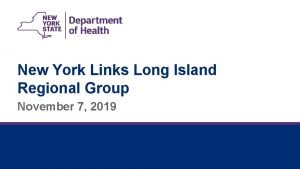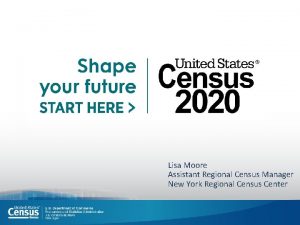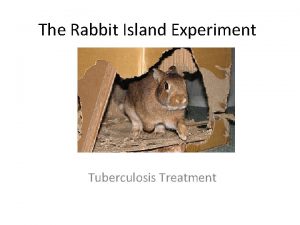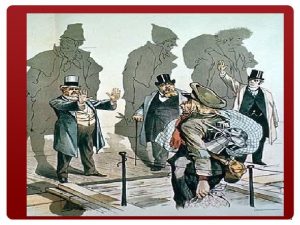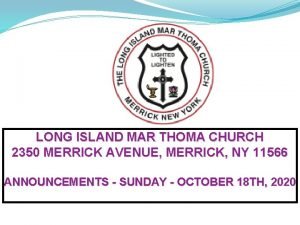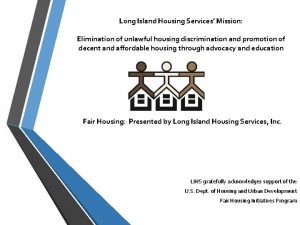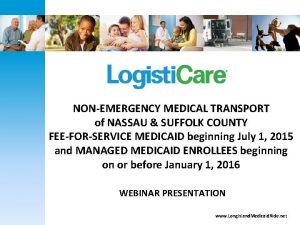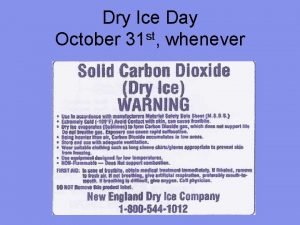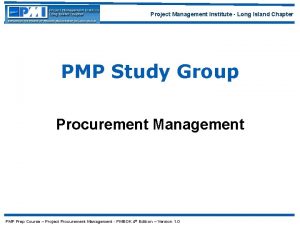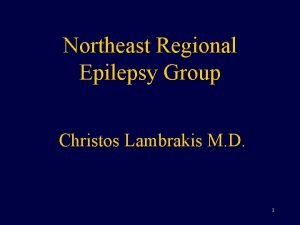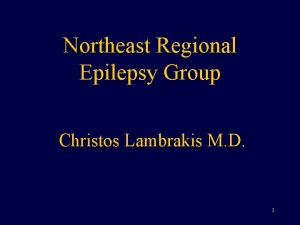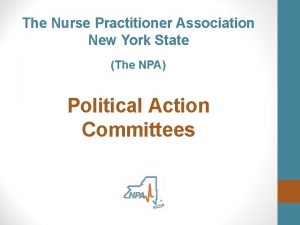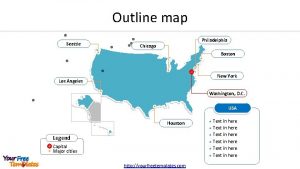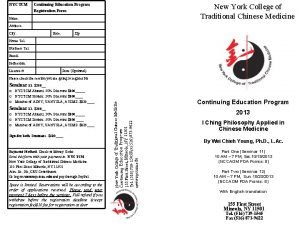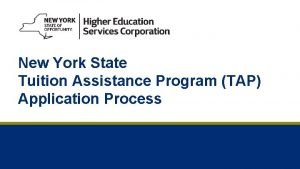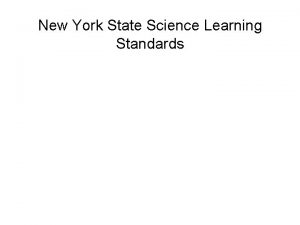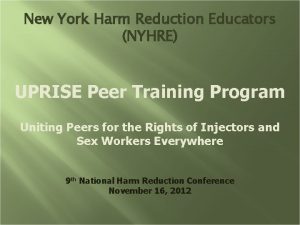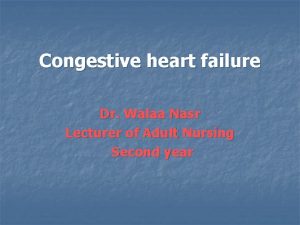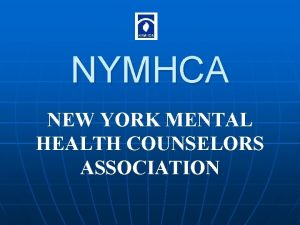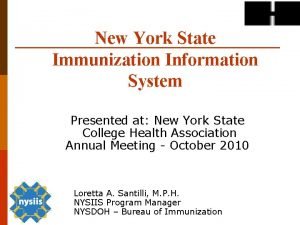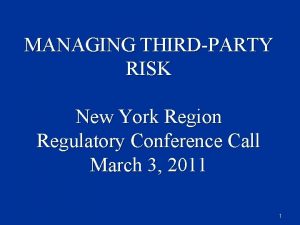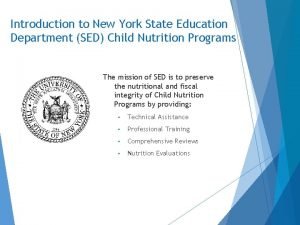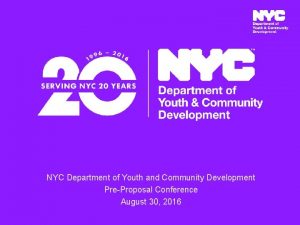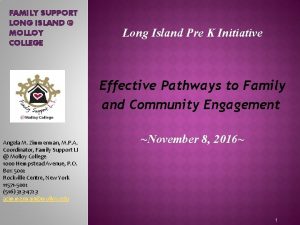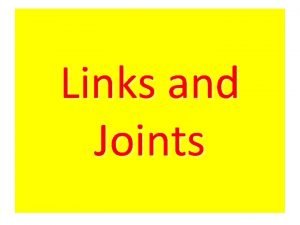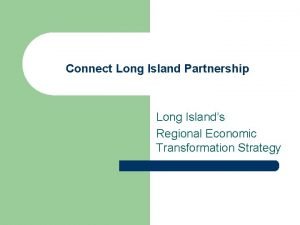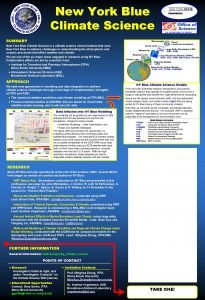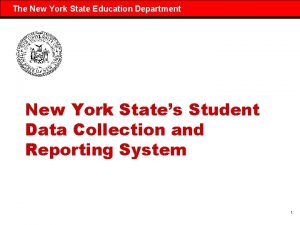New York Links Long Island Regional Group August


























































































- Slides: 90

New York Links Long Island Regional Group August 6, 2019

2

3 Link and retain persons diagnosed with HIV in care to maximize virus suppression so they remain healthy and prevent further transmission. BP 5: Continuously act to monitor and improve rates of viral suppression BP 7: Use client-level data to identify & assist patients lost to care or not virally suppressed BP 8: Enhance & streamline services to support the non-medical needs of persons with HIV. . . BP 29: Expand & enhance the use of data to track and report progress

4 NYLinks Overall Objectives • • Improve Linkage to Care Improve Engagement in Care Improve ART Adherence Improve Viral Load Suppression

5 Methods • • • Put our Public Health Hats on Involve Everyone Think in terms of Region and Community Use Data Identify Gaps in Care Identify Interventions to fill Gaps Use Quality Improvement Methodology Increase QI skill set Share with Everyone

Bureau of HIV/STD Field Services Partner Services Overview

7 Partner Services

What is Partner Services? 8 Assistance in efficiently linking persons that may have been diagnosed with syphilis, gonorrhea, chlamydia, and/or HIV and their partners to testing, treatment, medical care, prevention interventions and/or other appropriate support services in order to improve their health outcomes and reduce the risk of transmission to others.

What Partner Services Does 9 Partner Services Workers: ü Conduct patient interviews, partner elicitation, and partner notifications. ü Conduct rapid HIV tests for at risk individuals in the field. ü Contact providers to verify treatment and results were provided to the patient. ü Help locate community resources that will assist with transportation and other needed services.

What Partner Services Does, contd. 10 Partner Services Workers: ü Interview patients/partners at a providers office, coordinate care if needed, interviews, and follow up with providers. ü Provide risk reduction/harm reduction education and materials to at risk individuals. ü May be the only professionals to ever directly discuss sexual behaviors and risks with patients and partners.

Objectives of Partner Services Short term objectives: ü ü ü Ensure patient confidentiality. Immediate linkage to medical care. Ensure treatment for STIs. Identify and notify partners of exposure and refer for testing and treatment, as applicable. Provide prevention and risk reduction services. Reduce barriers to accessing care, provide referrals for prevention and supportive services, including Preexposure Prophylaxis. 11 Long term objectives: ü Reduce disease incidence. ü Decrease the rate of HIV/STI transmission. ü Decrease sexual and substance using behaviors that results in risk. ü Increase the proportion of HIV/STI infected individuals who are aware of their status. ü Increase the proportion of partners of those diagnosed with HIV who are notified, tested, linked to prevention, and linked to treatment/medical care.

12 Partner Services Components • Linkage to HIV/STD medical care • Promote continuity of care, retention and treatment adherence • Distribute condoms and harm reduction supplies • Inform patients and partners of locations with free supplies • Partner elicitation & notification • HIV testing and linkage to prevention interventions • Referrals for Pr. EP Medical Care Partners Safer sex & harm reduction supplies Prevention/ Supportive Services • Referrals for identified supportive services • Risk reduction education & prevention counseling

13 Example of Partner Services at Work! • A male patient was diagnosed with secondary syphilis. • Partner Services worker interviewed the male patient and elicited one female sex partner. • Partner Services worker referred the female sex partner to the STI clinic for testing/treatment. She tested positive for syphilis. • Partner Services worker interviewed the female sex partner. • The female sex partner named the original male partner and an additional (female) partner of the original patient. • Partner Services worker referred additional partner (female) to the STI clinic. • Partner Services worker conducted a re-interview with the original male patient. • The patient then named an additional male sex partner.

1 4 14 Expanded Partner Services

Expanded Partner Services 15 Partner Services workers are specifically trained to address the various needs of individuals that have stopped or have been disconnected from care by providing resources and care coordination assistance. Expanded Partner Services is an extension of Partner Services that addresses the needs of patients with HIV that have discontinued their care. Expanded Partner Services cases are initiated when a patient hasn’t had bloodwork in ≥ 13 months. Once this occurs, an Expanded Partner Services worker is assigned the case for follow-up.

1 6 16 Disease Incidence on Long Island

17 Potential Transmission of Infection without Disease Intervention

Incidence of HIV/STDs in NYS (excluding NYC) 2018 • • • 47, 225 chlamydia 11, 194 gonorrhea 1, 232 early syphilis 2017 • 2, 877 HIV diagnoses 18

19 Sexually Transmitted Infections New York State excluding New York City (NYC), 2018 Years of consecutive increases: Congenital Syphilis Chlamydia Gonorrhea 47, 225 Cases 11, 194 Cases P&S Syphilis 1, 232 Cases 4. 6% 5. 4% 9. 1% 12. 5% 2017: 45, 153 cases 2017: 10, 620 cases 2017: 1, 129 cases 2017: 8 cases 6 6 10 3 9 Cases

20 Long Island Region* 2018 STI Surveillance Increases Highlighted CHLAMYDIA 4. 6% 2017: 9, 478 | 2018: 9, 991 7. 2% increase among males 66. 1% of diagnoses among females Created by: Bureau of Sexual Health and Epidemiology GONORRHEA 4. 1% 2017: 1, 477 | 2018: 1, 538 6. 0% increase among males 68. 9% of diagnoses among males EARLY SYPHILIS 3. 8% 2017: 319 | 2018: 331 4. 2% increase among females 92. 4% of diagnoses among males *Map legends correspond to statewide rate map

21

What Partner Services can do for Providers 22 q Assist providers with patient notification of test results and provide referrals to patients and partners for testing/treatment. q Work with providers if a patient is lost to follow up. q Provide information/in-house education on Partner Services and Disease Intervention. q Assist in interpretation of test results (syphilis and HIV) and act as consultants on HIV/STD cases. q Partner Services will assist providers in submitting the DOH-4189 (Medical Provider HIV/AIDS and Partner/Contact Form, also known as PRF) in a timely manner. Providers can also sign up for access to the New York State Department of Health portal for easy reporting. https: //www. health. ny. gov/diseases/aids/providers/regulations/partner_services/docs/partner_ services_materials. pdf

What Providers can do for Partner Services 23 q Assist partner services by sharing information about patients and their test results. q Provide partner services staff investigating a case with patient information in a timely manner. q Appoint a contact person for partner services staff that will allow staff to quickly make an appointment for partners that require testing and treatment. q Provide a variety of NYSDOH and Centers for Disease Control and Prevention approved treatment options and approaches, i. e. Expedited Partner Therapy (EPT) and Preventative Treatment. q Inform patients that they can expect a call from the Department of Health and encourage participation in the partner services process. q Be helpful and collaborate with Partner Services staff and aid in the process to promote sexual health and reduce transmission.

24 For more information contact: Santo Barbagiovanni, LMSW Santo. barbagiovanni@health. ny. gov PHR IV/Program Manager Metropolitan Area Regional Office 914 -654 -7157 Vishal Kinkhabwala, MD Vishal. Kinkhabwala@health. ny. gov Public Health Rep II Metropolitan Area Regional Office 914 -654 -4390

New York State Proposed Training of Consumers on Quality (TCQ) Plus Orientation Webinar August 2019

Presenters Steve Sawicki Lead 26 Daniel Tietz Director Consumer Affairs AIDS Institute

TCQPlus Agenda Ø Introductions Ø Goals & Learning Objectives Ø Participant Expectations Ø Application & Selection Process Ø Questions & Answers 27

Participant Introductions § What is your Name? § What is your role? § What is your Organization Affiliation? 28

Policy Clarification Notice 15 -02 In 2015, the HIV/AIDS Bureau published Policy Clarification Notice (PCN) 15 -02 – Clinical Quality Management (CQM) Policy Clarification Notice. The purpose of the PCN is to clarify the RWHAP expectations for clinical quality management programs. This training is written with PCN 15 -02 in mind and, in part, its purpose is to assist RWHAP recipients in meeting these requirements. https: //hab. hrsa. gov/sites/default/files/hab/clinical-qualitymanagement/clinicalqualitymanagementpcn. pdf 29

AIDS Institute Quality of Care Program Standards for Consumer Involvement in Quality Improvement Consumer(s): Are routinely asked to provide input/feedback in the selection of quality improvement (QI) priorities Participate in HIV quality management (QM) program activities, as members of the QM committee Provide feedback on the HIV QM program by responding to formal solicitations for public comment and by participating in an organization’s consumer advisory board. Are offered opportunities to participate in trainings in QI and are provided with an organization’s performance data results and findings. Experience is assessed at least annually and findings are formally integrated into QI activities and communicated back to staff and consumers, as specified in the guidance issued by the AIDS Institute 30

Consumer Involvement Cascade Guidance • Provide an explanation of how consumers were engaged in the process of developing the quality improvement plan based on the data in the cascad es. • Explain how consumers were given the opportunity to learn about the methodology used to define each indicator and to construct each bar on the treatment cascades, including how the numerator and denominator were derived. 31

32

NY State TCQPlus Goals 33 • Foster a working relationship between consumers and HIV prevention and care providers to form TCQPlus training partners. • Plan and deliver local TCQ training programs by the TCQPlus training partners. • Develop regional training capacity among consumers and providers to deliver quality improvement trainings in local jurisdictions. • Increase the number of consumers and providers who attend a TCQ program training conducted by TCQPlus graduates • Increase the number of consumers who are active members of provider and NYLINKS regional level clinical quality management program activities

TCQPlus Learning Objectives • Provide overview of the Ryan White HIV/AIDS Program (RWHAP) and its CQM expectations for recipients/sub-recipients • Familiarize participants with basic principles of adult learning theory and increase capacity to apply these principles when designing and delivering training programs • Create a safe space for participants to discuss civic engagement, evaluate relationships, and to review frameworks to engage consumers in quality improvement activities • Familiarize participants with clinical quality management principles and terminology 34

TCQPlus Learning Objectives • Learn and demonstrate how quality management teams and committees make decisions to solve problems • Create space for participants to reflect on real life experiences to be change agents • Review concepts of health numeracy, performance measurement, and quality improvement • Provide planning tools and resources to design and deliver local TCQ programs 35

Pre-TCQ Participant Expectations • Identify and select NYLINKS regional group members to form up to training team(s) § Up to 2 teams per regional group § Each training team will include one staff from a provider organization and up to two consumers. • Complete pre-work assignments by participating in 3 webinars on topics that include: § Provide overviews of TCQPlus Program and Ryan White Program quality expectations § Familiarize participants with basic principles of adult learning and discuss how these principles relate to designing learning experiences § Read two essays on different methods of involvement including agitation, activism, and advocacy 36

Participant Expectations During TCQPlus § Attend actively participate in TCQPlus in- person session • Approximately 2 ½ full days of training (Proposing to deliver sometime in March 2020 - Dates TBD) § Training Location • Location TBD 37

Post-TCQ Plus Participant Expectations 38 § Participate in follow-up webinar for networking and staying connected to members of TCQPlus training team § Design and deliver two (2) ½ day local TCQ Programs within 2 -4 months after attending TCQPlus § Identify and recruit consumers and providers to participate in local TCQ programs § Work with AIDS Institute staff to plan TCQ program logistics (i. e. , space, food, training materials, etc. ) § Report back to AIDS Institute staff on TCQ program(s) delivered and outcomes using survey monkey tool § Participate in future clinical quality management capacity building webinars

TCQPlus Participant Selection Process 39 § Each NYLINKS regional group should determine who has the time, energy, and commitment to participate in the TCQPlus program § Up to two PLWHA and one staff member can make up a training team § All members of each training team should be or plan to be actively engaged in clinical quality management program activities § Up to two training teams can be selected for each NYLINKS regional group § Provider staff must review and sign “Recipient Agreement” to participate in the TCQPlus on behalf of the training team § Agree to assist with logistical planning of regional TCQ program(s) § Serve as regional content experts and present on facility or regional level cascade data during regional TCQ programs. § The deadline to select NYLINKS regional training teams is January 31, 2020

TCQPlus Implementation and Delivery Timeline June 2018 Secure funding a schedule TCQPlus Overview Presentations within each NYLINKS regional group for outreach and recruitment Fall 2019 January 2020 Secure training venue (NENY or Hudson Valley) January 2020 Identify NYLINKS Regional team members (1 Provider and up to 2 consumers) per team. A maximum of 2 teams per regional group 40 February 2020 October 2018 June 2019 Schedule and deliver 3 Prework webinars (2 weeks prior to TCQPlus) March 2020 Identify TCQPlus faculty (TCQPlus graduates, content experts, and lead trainers) March 2020 TCQPlus program Follow-up evaluation activities and planning webinar booster sessions June 2020 Deliver 1 st NYS TCQPlus program

Questions?

Contact Information Daniel Tietz, Director of Consumer Affairs New York State Department of Health AIDS Institute (518) 486 -7302 (voice) daniel. tietz@health. ny. gov 42

Thank You : -) This project is supported by the Health Resources and Services Administration (HRSA) of the U. S. Department of Health and Human Services (HHS) under grant number U 28 HA 30791 and the HRSA Ryan White HIV/AIDS Program Implementation Center for HIV Quality Improvement and Innovation for $1. 5 M. This information or content and conclusions are those of the author and should not be construed as the official position or policy of, nor should any endorsements be inferred by HRSA, HHS or the U. S. Government.

Understanding Variation and the Tools Used to Identify It

45 Learning Objectives • Impart a basic understanding of the two types of variation • How variation affects quality improvement as defined by PCN 15 -02 • Basic understanding of control charts and their construction • How to find hidden special cause variation in your data • How variation may hinder your improvement efforts

46 Introduction This webinar is divided into two parts to illustrate the concepts of variation and its application. The idea of variation arose from probability interpretations discussed as early as 1703 by Gottfried Leibniz. It was Walter Shewhart who used statistics to examine variations in manufacturing data. His observations led to the discovery that processes display variation, some variation is controlled (common cause) and some is uncontrolled (special cause). https: //history-biography. com/walter-a-shewhart/

47 Why Understanding Variation Is Important • Fluctuations in data measured over time may or may not indicate a problem in a system • Not all fluctuation in a system is bad • The behavior of a system can be influenced by factors external to the system

48 Understanding Variation

49 Why Understanding Variation Is Important • Quality improvement is defined in PCN 15 -02 (revised 11/30/2018) • PCN 15 -02 states that “Quality improvement entails the development and implementation of activities to make changes to the program in response to the performance data results. ”* * https: //hab. hrsa. gov/sites/default/files/hab/Global/CQM-PCN-15 -02. pdf

50 Why Understanding Variation Is Important If you do not interpret your data correctly, it can lead to problems • Fluctuations in data measured over time may or may not indicate a problem in a system • Not all fluctuation in a system is bad • The behavior of a system can be influenced by factors external to the system

51 Understanding Variation Your Drive to Work • Your drive to work takes you anywhere between 3040 minutes (28 m if you hit the lights just right) • Some days there seems to be more traffic than others and that slows you down. – Think of your drive as a process with some mild variation – You can reasonably predict the outcome of your commute – Its impossible for you to predict the volume of traffic on the road on a given day – To effectively measure variation, it should be measured and graphed over time

52 Understanding Variation Your Drive to Work Commute in Minutes by Work Days 45 40 Commute in Minutes 35 30 Mean = 34 25 20 15 4/2 4/4 4/6 4/8 4/10 4/12 4/14 4/16 4/18 Date of Commute 4/20 4/22 4/24 4/26 4/28 4/30

53 Understanding Variation Your Drive to Work – Think of your drive as a process with some mild variation – You can reasonably predict the outcome of your commute – Its impossible for you to predict the volume of traffic on the road on a given day – To effectively measure variation, it should be measured and graphed over time

54 What’s Going On in Our Example The system we just discussed – our commute – displays common cause variation. But why? – Common cause variations are the normal variations that occur in a system. In our example, the traffic volume creates a normal variation in arrival time – The outcome is predictable (30 – 40 minutes) – This noise can lead to producing undesirable results even though we say the system is stable http: //qualityamerica. com/LSS-Knowledge-Center/statisticalprocesscontrol/statistical_process_control_defined. php

55 Common Cause Variation Let’s look at the idea of a stable system • A stable system means that the variation in our processes - the noise - is within the limits of acceptable variation • This doesn’t infer that the system is performing well • There are opportunities to improve the system by eliminating the noise http: //qualityamerica. com/LSS-Knowledge. Center/statisticalprocesscontrol/statistical_process_control_defined. php

56 Understanding Variation Your Journey Continues You start your commute as you do any other day, but then: • A water line ruptures and you now have to detour • It takes you 75 minutes to get to work and the repair is going to take four weeks to complete. • The detours will also change over the course of the four weeks.

57 Special Cause Variation Because of the construction on our trip, our time went from 30 – 40 minutes to over an hour every day. This is a special cause variation because: – The delay in our trip was caused by something not part of our normal trip – The time of our trip is now unpredictable due to changing routes – Special cause variations can have either a favorable or unfavorable effect on a process – The effect of an occurrence outside of the normal variation within a system was so severe it created a drastic change from our commute

58 Special Cause Variation • Special cause variations arise from specific circumstances • They may be part of a process but are caused by events not part of a process (remember the water main break) • Special cause variations can be identified and possibly fixed

59 Identifying Variation Through Charting • A run chart can be useful to determine variation and goal • We need a data set that with at least 15 - 20 data points measured over time • We need as complete a data set as possible • We need to set our goals for ideal and acceptable performance • The following example does not have the same statistical rigor as a control chart

60 Variation in Healthcare Viral Suppression Viral Load Suppression Rates Over Time 100 90 80 78 72 70 67 78 75 75 74 80 78 73 70 67 64 60 50 40 30 30 20 10 0 2/16 4/16 6/16 8/16 10/16 12/16 2/17 4/17 Month/Year 6/17 8/17 10/17 12/17 2/18 4/18

61 Summary • Variation can be either good or bad; its important to determine the type of variation you have in your system • Special cause variation is external to the system but effects it; the effect can be either good or bad • In healthcare, it is at times best to establish your own upper and lower limits to understand the behavior of your process or system • To use a more structured approach to variation, we need to use a control chart

62 The Shewhart Chart and Control Limits Part 2

63 Introduction This section explains the control chart and its usefulness in examining special cause variation – Offers a quantifiable result to establish special cause variation – It shows if a process is in statistical (measurable) control

64 Introduction “Walter Andrew Shewhart…was an American physicist, engineer and statistician, sometimes known as the father of statistical quality control. “ W. Edwards Deming said of him: “As a statistician, he was, like so many of the rest of us, self-taught, on a good background of physics and mathematics. ” Deming, W. Edwards (1967). "Walter A. Shewhart, 1891 -1967". The American Statistician. 21 (2): 39– 40. Journal of Storage 1401495

65 Statistical Control • Shewhart advanced the idea of statistical control; an analysis of data points that when graphed, show a process “behaves” • To determine statistical control, we need a run chart with: – A central line to determine trends over time (a mean or median) – An upper and lower limit (the acceptable +/- 3 standard deviations of the expected value) – At least 15 - 20 data points are plotted • These additional elements turn a run chart into a control chart

66 Control Charts • Control charts – also called process behavior charts – reflect the performance of a process over time • They can be used to predict performance based on prior behavior • They are a necessity in determining variations in a process or system 2 eler, D. J. , (2000). ‘Understanding Variation; the Key to Managing Chaos’. SPC Press (Rev. ed. ), Knoxville, TN, p. 153

67 Control Charts 30 Upper control limit 25 minutes 20 mean 15 10 lower control limit 5 1 2 3 4 5 6 7 8 9 10 11 12 13 14 15 Each patient’s wait time in minutes 16 17 18 19 20 21 22 23 24

68 Control Charts In our prior example, we saw that: – The mean and upper and lower control limits were established mathematically – No data points were outside the control limits; our process is said to be in statistical control

69 Statistical Control But suppose our chart looked like this 30 25 Minutes 20 15 10 5 1 2 3 4 5 6 7 8 9 10 11 12 13 Measures 14 15 16 17 18 19 20 21 22 23 24 This is an example of special cause variation. Why?

70 Statistical Control • The example on the previous slide is an example of special cause variation • In the example we can see that: – A few points are outside the lower and upper control limits – Our results vary widely indicating noise even in data points that are with in the control limits

71 Evolution of the Control Chart • Over time, guidelines have been put forth by statisticians to help consistently interpret the charts: – – A point on a limit is not considered outside the limit A point on the center line is not included in a run; a ‘run’ being consecutive points such as 6 or above Ties between 2 consecutive points do not add to or cancel a trend When there is no limit on one side of the center line (such as a result which yields 100%) you do not apply any of the rules to the side missing the limit • These assist in further analyzing the data and pointing out trends that may lead to special cause variation 3 3 Porvost, L. , Murray, S. , (2011). ‘The Health Care Data Guide’; Josey-Bass, San Francisco, CA; pp. 116 -117

72 Rules for Identifying Special Cause Variation There is special cause variation when: 1. There is a single point outside the control limit 2. There is a run of eight or more points in a row above or below the centerline 3. There are six consecutive points increasing (trending up) or decreasing (trending down) 4. There are two out of three consecutive points near (outer one third) a control limit 5. There are 15 consecutive points close (inner one-third of the chart) to the centerline

73 Rule One When a single point is outside the control limits there is a special cause variation Example for Rule One 30 25 minutes 20 15 10 5 1 2 3 4 5 6 7 8 9 10 11 12 13 14 15 16 17 18 19 20 21 22 23 24 Measures

74 Rule Two A run of eight or more points in a row above or below the center line defines special cause variation Example of Rule Two 30 25 Minutes 20 15 10 5 1 2 3 4 5 6 7 8 9 10 11 12 13 14 15 16 17 18 19 20 21 22 23 24 Measures

75 Rule Three minutes Six consecutive points increasing or decreasing define a special cause variation Example of Rule Three 30 25 20 15 10 5 0 1 2 3 4 5 6 7 8 9 10 11 12 13 14 15 16 17 18 19 20 21 22 23 24 measures

76 Rule Four Two out of three consecutive points near the outer one third of a control limit define a special cause variation Example of Rule 4 30 minutes 25 20 Near the outer one-third of the center line 15 10 5 0 1 2 3 4 5 6 7 8 9 10 11 12 13 14 15 16 17 18 19 20 21 22 23 24

77 Rule Five Fifteen consecutive points close (inner one third) to the centerline constitute a special cause variation minutes Example of Rule 5 Inner 1/3 of the center line 30 25 20 15 10 5 0 1 2 3 4 5 6 7 8 9 10 11 12 13 14 15 16 17 18 19 20 21 22 23 24 measures

78 Summary of Five Rules • These rules are derived over time to further identify special cause variation • Data must be carefully plotted for these patterns to become evident • These five rules can be used in improvement projects to spur further investigation or to judge the effectiveness of your improvement activities

79 Can Control Charts Be Used in Healthcare? One study applied control charts to examine clinical variables in four common medical conditions and concluded they have a promising role but need more rigorous evaluation 4 4 R. Tennant, M. Mohammed, J. Coleman, U. Martin (2007). “Monitoring patients using control charts: a systematic review”. International Journal for Quality in Health Care. http: //dx. doi. org/10. 1093/intqhc/mzm 015 First published online: 1 June 2007, pp. 187 -194

80 Can Control Charts Be Used in Healthcare? When you want to determine what type of control chart to use (run chart with goals or a control chart) remember this: – Let common sense prevail; you cannot have more than 100% of something or less than zero – Control charts follow precise mathematics – Remember the five rules and look for the patterns within the data

81 Summary • • • The idea of variation was based on earlier works far back as the 1700 s Processes have inherent variations categorized as common cause and special cause variation Run charts are an effective way of determining variation Special cause variation can be present in a system and following the guidelines for run charts and analyzing variation will help identify variations Deeper analysis of your data leads to a better understanding of what may need to be improved

82 Resources • • • Wheeler, D. , (2000). Understanding Variation; The Key to managing Chaos (2 nd edition). Knoxville, TN. SPC Press. Provost, L. , Murray, S. (2011). The Health Care Data Guide; Learning From Data for Improvement. San Francisco, CA. Jossey-Bass Knowledge Center. http: //qualityamerica. com/LSS-Knowledge. Center/statisticalprocesscontrol/statistical_process_control_defined. php • R. Tennant, M. Mohammed, J. Coleman, U. Martin (2007). “Monitoring patients using control charts: a systematic review”. International Journal for Quality in Health Care. http: //dx. doi. org/10. 1093/intqhc/mzm 015 First published online: 1 June 2007, pp. 187 -194

LUNCH 83

Working Lunch: Preparing for Breakout session 84 • Identify 1 -2 biggest challenges for your topic (i. e. engagement, linkage retention), in the form of problem statements • DEFINE problem statements to be explore in breakout session

85 Examples of Challenges • • Lack of HIV-related health services for YA Inconvenient clinic hours Mental health / substance use Unstable housing

86 Example of a Problem Statement: • There is a lack of medical care providers for young adults living with HIV/AIDS. What are actionable strategies to recruit and retain providers in HIV medical care for YA?

87 Breakout Session • SHARE your identified challenges and problem statements for your challenges with the group • As a group, CHOOSE 2 of the problem statements shared by members of your group • DISCUSS and identify proposed solutions / actions to take against problem statements • PRESENT solution proposals to the full group (may be multiple proposals/problem) • DECIDE as a group if there any specific problem-solution pairs worth pursuing, and define next steps to begin taking action

Future NYLinks Meetings • • NYLinks Regional Meeting-Lower Manhattan: August 9, 2019 NYLinks Regional Meeting-Upper Manhattan: August 16, 2019 NYLinks Regional Meeting-CNYRO: August 28, 2019 NYLinks Regional Meeting-Northeastern NY: September 17, 2019 NYLinks/ETE Queens-September 25, 2019 NYLinks Regional Meeting-Long Island: November 6, 2019 NYLinks Regional Meeting-Lower Manhattan: November 26, 2019 NYLinks Regional Meting-Northeastern NY: December 10, 2019 88

Contact Information Steve Sawicki, NYLinks Lead, steven. sawicki@health. ny. gov Regional Leads Upper Manhattan—Susan Weigl sweigl@yahoo. com Lower Manhattan—Susan Weigl Western NY—Steven Sawicki Long Island—Febuary D’Auria, febuary. dauria@health. ny. gov Central NY & Southern Tier—Laura O’Shea, laura. oshea@health. ny. gov Mid & Lower Hudson—Steve Sawicki Queens—Nova West, nova. west@health. ny. gov Brooklyn—Clemens Steinbock, clemens. steinbock@health. ny. gov & Zeenath Rehana zrehana@health. nyc. gov Bronx—Dan Belanger, dan. belanger@health. ny. gov Northeastern NY—Steve Sawicki Staten Island—Steve Sawicki Statewide TA for Consumer Involvement in Quality Improvement—Dan Tietz, Daniel. Tietz@health. ny. gov And Remember to visit the webpage at: www. newyorklinks. org 89

90 …in closing “What are we here for? To have fun, to learn and to make a difference. ” -W. Edwards Deming https: //www. youtube. com/watch? v=f. W 8 am. MCVA JQ
 New york links
New york links New york regional census center
New york regional census center Isle island new york
Isle island new york Rabbit island new york
Rabbit island new york Hotel emerald thassos
Hotel emerald thassos Marketo learning passport
Marketo learning passport New york pennsylvania new jersey delaware
New york pennsylvania new jersey delaware New hartford theater
New hartford theater Articles of confederation strengths and weaknesses
Articles of confederation strengths and weaknesses Neil thisse is a loyalist answers
Neil thisse is a loyalist answers Tall+short h
Tall+short h Once upon a time there lived a fox
Once upon a time there lived a fox What is island
What is island Ellis island vs. angel island
Ellis island vs. angel island Ellis island and angel island venn diagram
Ellis island and angel island venn diagram Island of the blue dolphins island map
Island of the blue dolphins island map Where is east egg and west egg in the great gatsby
Where is east egg and west egg in the great gatsby Limtc.org
Limtc.org Long island housing services
Long island housing services Plainview old bethpage soccer
Plainview old bethpage soccer Montauk monster
Montauk monster Gardiners farm
Gardiners farm Neuro linguistic programming long island
Neuro linguistic programming long island Logisticare suffolk county
Logisticare suffolk county Dry ice safety
Dry ice safety Walt whitman house long island
Walt whitman house long island Agritourism long island
Agritourism long island Long island marthoma church
Long island marthoma church Pmi long island
Pmi long island Long island aerospace companies
Long island aerospace companies Long island power supply
Long island power supply Northeast epilepsy group
Northeast epilepsy group Ne regional epilepsy group
Ne regional epilepsy group Ne regional epilepsy group
Ne regional epilepsy group New york business etiquette
New york business etiquette Procedural vs substantive due process
Procedural vs substantive due process Merriweather library
Merriweather library Nys npa
Nys npa Swashbuckling trio of old
Swashbuckling trio of old Taoki new york
Taoki new york Map of new york and philadelphia
Map of new york and philadelphia Volomandra
Volomandra Ny college of traditional chinese medicine
Ny college of traditional chinese medicine The new york times upfront
The new york times upfront Application for tap
Application for tap New york state teacher certification examinations
New york state teacher certification examinations New york state standards science
New york state standards science Ccta new york
Ccta new york Nys test 2018
Nys test 2018 Lega amerike
Lega amerike Nyhre
Nyhre Distretti new york
Distretti new york Map of harlem 1920s
Map of harlem 1920s Nysalm
Nysalm Dmi new york
Dmi new york Hunger in new york city poem analysis
Hunger in new york city poem analysis New york scale heart failure
New york scale heart failure West egg new york
West egg new york New york oceanic
New york oceanic New york 7
New york 7 New york hf classification
New york hf classification Federal district court map new york
Federal district court map new york Gitlow v new york constitutional question
Gitlow v new york constitutional question Avaya new york
Avaya new york Nys mesonet now
Nys mesonet now 102 graphic
102 graphic My dad (fly just) from new york
My dad (fly just) from new york State vegetable of new york
State vegetable of new york New york kerületei
New york kerületei Nys environmental facilities corporation
Nys environmental facilities corporation 60s poets
60s poets American mental health counselors association
American mental health counselors association New york statewide senior action council
New york statewide senior action council New york state professional firefighters association
New york state professional firefighters association New york state immunization registry
New york state immunization registry New york state association of transportation engineers
New york state association of transportation engineers Why is new york city called the big apple
Why is new york city called the big apple New york campus compact
New york campus compact New york city technology forum
New york city technology forum Third party risk management conference 2019 new york
Third party risk management conference 2019 new york Sed new york
Sed new york Rena abbasova new york
Rena abbasova new york New york
New york New york times v. sullivan
New york times v. sullivan Brainpop regions of the 13 colonies
Brainpop regions of the 13 colonies What state's capital is montpelier
What state's capital is montpelier Engage new york kindergarten
Engage new york kindergarten The formation of a pearl is an adventitious effect of
The formation of a pearl is an adventitious effect of The new york weekly journal
The new york weekly journal The standard
The standard Nyc department of youth and community development
Nyc department of youth and community development
